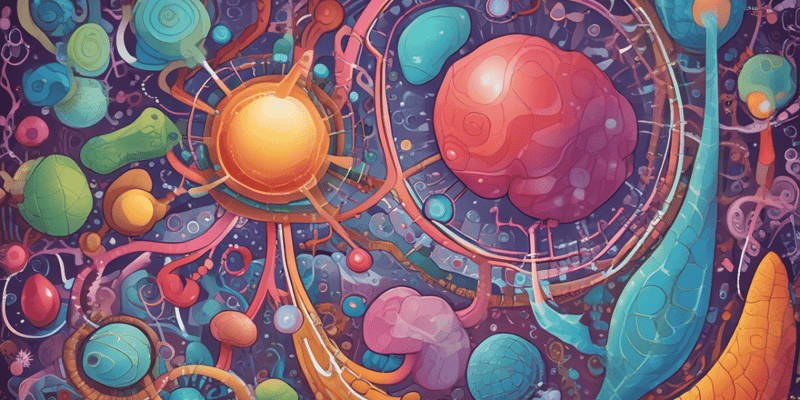Questions and Answers
¿En qué parte de la célula ocurre la glucólisis?
Citoplasma
¿Cuántas moléculas netas de ATP se generan por molécula de glucosa durante la glucólisis?
Dos
¿Qué moléculas se producen como resultado de la glucólisis?
NADH y piruvato
¿Qué proceso sigue a la glucólisis en la respiración celular?
Signup and view all the answers
¿Qué molécula es esencial para transportar electrones hacia la cadena de transporte de electrones?
Signup and view all the answers
¿Cuál es la función principal de la ATP sintasa en la respiración celular?
Signup and view all the answers
¿Cuál es la molécula que se convierte en adenosina difosfato (ADP) durante la respiración celular?
Signup and view all the answers
¿Qué proceso se activa en la respiración celular cuando el oxígeno es escaso o no está disponible?
Signup and view all the answers
¿Qué producto se forma durante la fermentación anaeróbica a partir de los piruvatos generados en la glucólisis?
Signup and view all the answers
¿Cuál es el sustrato más común en la respiración celular?
Signup and view all the answers
¿En qué reacción se libera energía al romperse un enlace de alta energía durante la respiración celular?
Signup and view all the answers
¿Qué tipo de proceso es la fermentación en términos de oxígeno?
Signup and view all the answers
Study Notes
Cellular Respiration: Fueling Life with ATP, Anaerobic Processes, and Glucose Breakdown
Cellular respiration is a collection of biochemical processes that occur within cells, converting energy-rich molecules into adenosine triphosphate (ATP) – the energy currency of life. This process is crucial for sustaining life and powering biological functions, from muscle contractions to maintaining cellular structures.
ATP: The Energy Currency of Life
ATP, or adenosine triphosphate, is a molecule composed of adenosine, three phosphate groups, and high-energy bonds. The energy released when ATP loses one of its phosphate groups (forming ADP, or adenosine diphosphate) powers biological processes. This breakdown, called hydrolysis, is an exothermic reaction, releasing energy.
Respiración Anaeróbica
An anaerobic process is one that does not require oxygen. In cellular respiration, anaerobic pathways are used when oxygen is scarce or unavailable. Two significant anaerobic pathways are:
-
Glycolysis: The process of breaking down glucose into two molecules of pyruvate, generating ATP through anaerobic glycolysis. This process does not require oxygen.
-
Fermentation: After glycolysis, the pyruvate molecules can be converted to lactate, ethanol, or other products, generating ATP through fermentation, which is also anaerobic.
Glucólisis: Breaking Down Glucose
Glucose, a simple sugar, is the most common substrate in cellular respiration. It is broken down into smaller molecules through a series of reactions called glycolysis. This process occurs in the cytoplasm of cells and generates a net gain of two ATP molecules per glucose molecule, as well as two molecules of NADH (nicotinamide adenine dinucleotide, reduced form) and two molecules of pyruvate.
The Citric Acid Cycle (TCA Cycle or Krebs Cycle)
The citric acid cycle, also called the tricarboxylic acid (TCA) cycle, or the Krebs cycle, is a series of chemical reactions that occur within the mitochondria. This cycle breaks down the pyruvate molecules produced during glycolysis into carbon dioxide and water, generating NADH and FADH2 (reduced form of flavin adenine dinucleotide) molecules. The energy stored in these reduced electron carriers is utilized in the electron transport chain to produce ATP.
The Electron Transport Chain (ETC)
The electron transport chain, located within the inner mitochondrial membrane, is a series of protein complexes that use the energy stored in NADH and FADH2 molecules to pump protons (H+) across the membrane, generating an electrochemical gradient. This gradient drives the movement of protons back into the matrix through ATP synthase, powering the synthesis of ATP from ADP and inorganic phosphate.
Oxidative Phosphorylation
Oxidative phosphorylation is the process in which NADH and FADH2 molecules generated during the citric acid cycle and glycolysis donate their electrons to the electron transport chain, resulting in the synthesis of ATP. This process utilizes the energy stored in the proton gradient to drive the synthesis of ATP.
Cellular Respiration in Summary
Cellular respiration is a series of metabolic processes that occur within cells, converting energy-rich molecules into ATP, the energy currency of life. Glycolysis, the citric acid cycle, and the electron transport chain are the primary processes involved in cellular respiration, generating ATP by converting glucose into carbon dioxide and water.
Studying That Suits You
Use AI to generate personalized quizzes and flashcards to suit your learning preferences.
Description
Descubre los procesos bioquímicos de la respiración celular, donde se convierten moléculas ricas en energía en adenosín trifosfato (ATP) - la moneda energética de la vida. Explora la importancia de la ATP, procesos anaeróbicos como la glucólisis y la fermentación, y la descomposición de la glucosa en el ciclo del ácido cítrico y la cadena de transporte de electrones.




